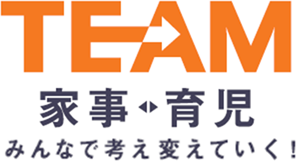As a matter of fact, I myself grew up without doing any housework at all, and when I lived alone and got married, I really had trouble with housework,” says Asako Homma, a housework producer. Her experience of struggling to balance work and housework led her to think about how to do housework in a way that saves time and wasted effort.
In this issue, Ms. Homma, an expert on “short-time housework,” will share her tips on “short-time housework” with young people who have started living alone and first-year working adults who are new to housework!

Tips for shortening housework time [Cleaning
Cleaning tools are within easy reach.
Place cleaning tools in “prime locations” in each room where they can be easily accessed, rather than hiding them away in a corner of the room. Placing them within easy reach eliminates unnecessary movement, and makes it easier to make “while-cleaning” and “on-the-spot cleaning” a habit. If you keep a handy mop in the top drawer of a shelf, you can easily take out the mop with one hand and dust with the other while talking on your phone.
Don’t make “cleaning time” but build it into your life.
When you are busy, it is difficult to go out of your way to make “cleaning time,” so make cleaning a part of your daily routine.
For example, after washing your face, use the towel you wiped your face with to wipe the mirror or washstand, clean the bathtub while taking a bath, or in the morning, grab the floor wiper in the bedroom and sweep the floor while moving to the bathroom or living room.
The Korokoro sheets with handles can also be hung with hooks on walls, refrigerators, or in the crevices of washing machines for cleaning during busy times.
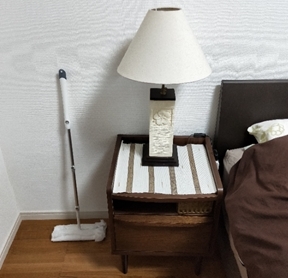
He who controls mold controls bath cleaning.
Mold decreases in fertility with heat above 50 degrees Celsius, so a slow application of hot water above 50 degrees Celsius is effective in preventing mold in the bath. Human stain is also a nourishment for mold. When showering, sitting rather than standing will reduce the extent of stained walls.
Bathroom ventilation is another effective way to prevent mold. When using an exhaust fan after bathing, close the window, and if the bathroom entrance door has a ventilation opening, close the door; if not, open the door about 5 cm to allow air to circulate. Dust that has accumulated in the vent should be removed, and a “spout washing brush” available at 100-yen stores can be used to efficiently clean the narrow spouts of teapots, teapots, etc.
Tips for short housework [tidying up
The first five minutes after returning home is the “magic hour.” Preventive cleaning keeps the house clean.
The first five minutes after you get home is the “magic time” when your room gets messy. If you put your bag, keys, mail, etc. “just for now,” they will start to clutter from there. By placing the necessary storage space for each item in the flow line when you get home, you can prevent clutter by storing them as you walk through the house. For example, “Hang the keys on the hook on the shoe box door at the entrance,” “Place the scissors and trash can near the bag rack,” and “Open the mail and dispose of unnecessary papers on the spot.
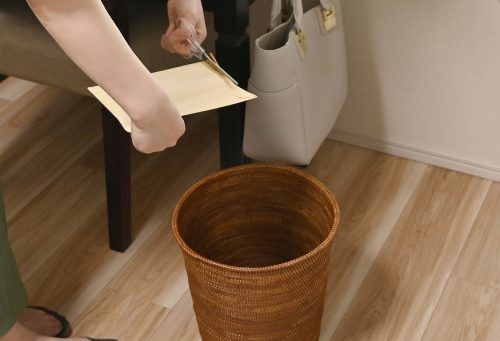
Utilize “hooks.”
To keep things off the floor, take full advantage of hooks. Attach them to the front door to hang coats, or to the back of a closet door to hang pajamas, glasses, or accessories.
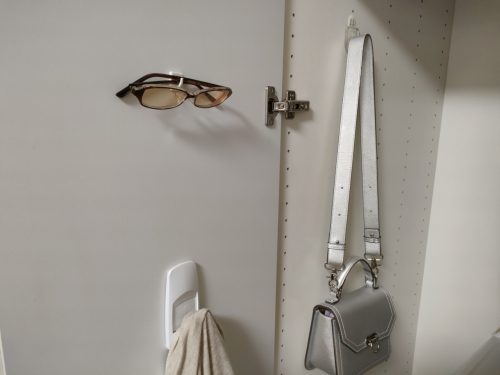
Tips for shortening housework time [Laundry
Washing, drying, and putting away are all done around the washing machine.
Laundry tends to be one of the longest work routines among household chores. As much as possible, consolidate the “wash,” “dry,” and “put away” areas. If the washing machine is placed at the center of the room, detergent and hangers can be placed where they can be quickly picked up without having to move. If you do not plan to install a washer and dryer, set up a drying corner above the washing machine with a stick-on rod or similar. Hang clothes on hangers and turn on the ventilation fan or dehumidifier to dry them on the spot. In addition, if you place a storage case for underwear and pajamas nearby, the work can be completed around the washing machine.
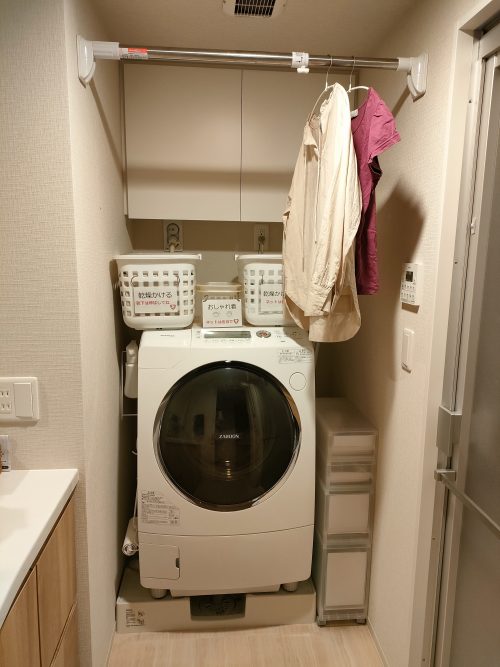
No need to iron shirts when using the special net
Using a special laundry net that prevents shirts from wrinkling and losing their shape saves time and effort in ironing. Also, if your fashionable clothes are not so delicate, you can wash them “normally” with a double laundry net. For bath towels, which take a long time to dry and are bulky to store, take the plunge and stop using them, substituting one or two face towels instead.
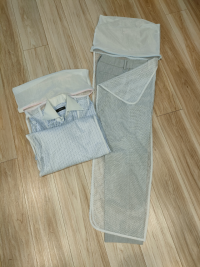
Tips for short housework [Cooking
Easy recipe using rice cooker and toaster
Rice cookers are useful for short cooking times. When cooking rice, you can add ingredients such as eggs and root vegetables wrapped in foil together and cook them, or you can easily cook stew in the rice cooker. If toasters are used not only for baking bread but also for cooking, they can be used for an even wider range of dishes. If you keep on hand a main dish of toasted foil with fish such as salmon, which can be done without using a frying pan or other cooking utensils, and simple side dishes such as namul made in a microwave oven, you can enjoy easy and tasty meals.
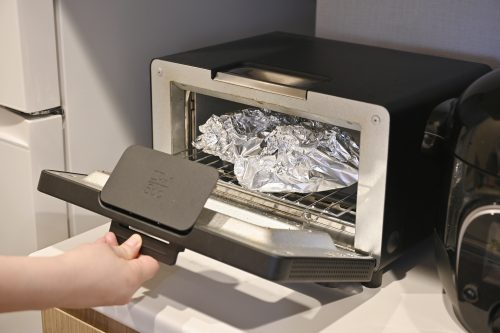
Convenient “breakfast set” that can be taken out quickly.
It is convenient to keep a case of “breakfast set” in the refrigerator. If you eat bread for breakfast, you can put jam and ham, and if you eat Japanese food, you can put natto and pickles in a case and put it in the refrigerator.
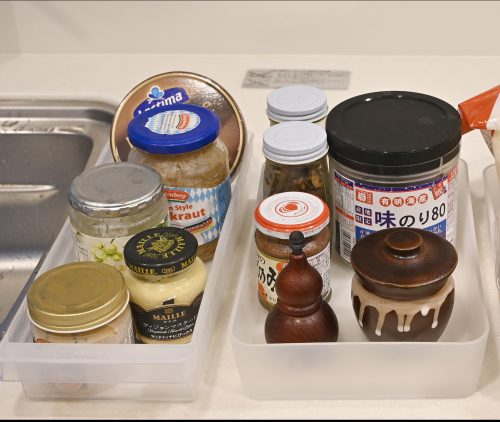
Shortening techniques to minimize the time and effort of washing dishes
Instead of using a knife and cutting board, we recommend using kitchen scissors. In particular, using kitchen scissors to cut chicken, whose skin is difficult to cut with a knife, and kimchi, whose smell is difficult to remove from a cutting board, makes cleanup easier. If you have a glass container with a lid that can be used in the microwave, you can cook the food in the microwave, serve it directly to the table, and store any leftovers in the refrigerator.
When making curry, add powdered agar together with the ingredients and simmer. When the curry cools down, it hardens and easily slides off the pot or plate, making washing up easier.
Dishwashers are also effective in shortening time. Recently, there are compact models that require no installation and take up little space, so it is a good idea to check them out.
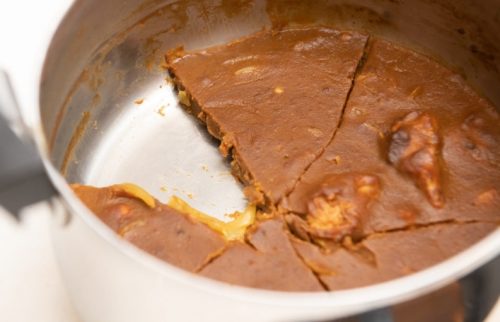
From now on, I believe that “people who can do housework” are “people who can help their families. If both men and women can acquire efficient housework know-how and become able to balance work and housework without difficulty, this will be useful when living with their partners in the future, and will lead to family happiness.

Asako Honma / Intellectual Housework Producer
After working as chief director of a food planning company, she became independent. Based on her own experience of struggling to balance work and housework, she devised a housework method called “intelligent housework” that saves time and unnecessary effort. She has solved the problems of many people who lament that they have no time or that housework is too much work, and has been featured on NHK’s “Asa Ichi,” Nippon Television’s “Hirunandes! and in magazines such as Croissant, Lettuce Club, and ESSE. He is the author of the book, “The Picture Shows! Room Design to Reduce Housework by 90%” (Seishun Shuppansha), “Muda Kajo ga Nigareta Seikatsu” (Sanctuary Publishing), “Zero Kajo” (Daiwa Shobo), and 12 other books in total. Her most recent book is “60-sai kara no tarenai kajo” (Tiredness-free housework from age 60) (Seishun Shuppansha).

